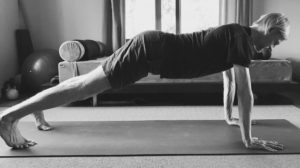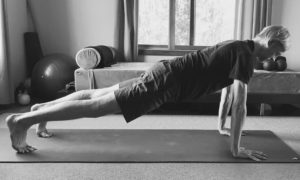Stair Mechanics – Walking Up
In this short video Tiffany details some of the most important features of functional mechanics when climbing stairs. This includes some of the most common mistakes and how to correct them.
In this short video Tiffany details some of the most important features of functional mechanics when climbing stairs. This includes some of the most common mistakes and how to correct them.
I’ve been really loving the short movement sequence shown in this video. It’s got a number of applications including stabilizing the hip joint, increasing range of motion in the hip, trunk stabilization and training for better throwing mechanics. I also find this sequence an ideal preparatory movement for classical standing asana in that it helps to awaken the movement patterns that really bring yogasana to life. Check it out!
This short video gives guided instructions for learning some DNS principles and using early developmental movements as a warm up for any movement practice you choose. I like to use this sequence as preparatory sequence before doing classical yoga postures, but it could also be done before a gym workout, a run, a bike ride or a hike.
We’re hoping to offer more video sessions like this and we’d love your feedback. Let us know what you think!
Ghee, or clarified butter, is commonly used in Indian cooking and especially Ayurvedic cooking. When made from good quality butter, especially butter from grass fed cows, ghee is loaded with fat soluble vitamins and beneficial fatty acids. And because ghee has a high smoke point, these nutrients aren’t destroyed in the cooking process.
From an ayurvedic perspective, ghee is considered a digestive in that it helps to improve absorption and assimilation of nutrients. Therefore ghee not only provides valuable nutrients on its own but makes the nutrients in our food more available to our tissue. Ghee is also used in ayurvedic medicine as an important carrier of herbs because helps to deliver these herbs and their effects to all of the tissues in the body.
When we make ghee, we are removing the moisture and milk solids from the butter. This includes the lactose and casein protein and therefore ghee is fine for people who are lactose intolerant or have a sensitivity to dairy sometimes caused by exposure to casein.
Ghee can have high concentrations of conjugated linoleic acid (CLA) and butyrate. There is some scientific evidence to suggest that CLA my help reduce body fat, inflammation and blood pressure. One study suggested that CLA may also prevent the formation of cancer cells.
Butyrate or butyric acid is a fatty acid important to gut health. Our gut flora make butyrate as it is an source of nourishment to the cells in our colon. Some studies have suggested that butyrate may support healthy insulin levels and thus may help regulate blood glucose. Studies also suggest butyrate may help reduce inflammation in the digestive system and might therefore be helpful for individuals with ulcerative colitis or Crohn’s disease.
Best of all, ghee is delicious and when made properly has virtually an unlimited shelf life. It can be used in place of any other cooking oil when sautéing vegetables or pan frying fish or tofu, and it’s great spread on toast!
When we’re faced with pain it’s easy to wonder, “why did this happen to me?” Seeking a cause for pain can be helpful, but only if we’re willing to consider the possibility that the pain is the result of how we’ve been using our body, or in many cases, not using it.
Human beings as a species have been successful on this planet largely due to our uncanny ability to adapt to our environment. Our bodies are extremely well adapted to the hunter gatherer lifestyle of our distant ancestors, for example, and like these ancestors we thrive on a wide variety of foods and the great number of human movements once required to collect them.
The breakneck pace of technology, however, has placed great demands on our ability to adapt to changes in diet and lifestyle. With very high calorie foods so easy to come by with so little physical effort, even relatively young people must all guard against diseases unheard of in the few hunter gatherer populations still remaining on this planet.
Perhaps the solution is getting more exercise, but this is highly debatable. The true purpose of exercise is to provide a substitute for the movement we’re not doing and the calories we’re not using in our increasingly technologically driven and sedentary modern lifestyle, but most of what we do for exercise these days reinforces the very lifestyle habits we’re already spending most of our days doing. Is sitting on a bike pedaling for an hour better than siting still in a chair? Maybe a bit, but it’s still sitting and can still contribute to many of the same health consequences.
In her 2015 book Don’t Just Sit There, Katy Bowman speaks to this issue when she says “the sitting itself isn’t really the problem, it is the repetitive use of a single position than makes us literally become ill in a litany of ways.” She goes on to give several examples including that “muscles will adapt to repetitive positioning by changing their cellular makeup, which in turn leads to less joint range of motion.”
I find myself telling my clients and students constantly that muscles adapt to the position we put our bones in. For instance If I stand with my hip joints forward of my knees and ankles, my hamstrings and calve muscles will shorten, limiting my ability to bend forward from my hips and placing greater demands on muscles and joints in my lower back.
These “adaptive” changes manifest to a certain extent over a period of time, but in some cases this type of adaptation can be very quick, even instantaneous. In the hips forward misalignment described above, the affects on muscle length and range of motion can actually happen rather quickly. Standing with the hips pushed forward turns off the muscles in the posterior hip and lower back. This doesn’t take any time at all, it simply happens as a result of doing it.
This turning off of the hip muscles is also a kind of adaptation and I actually consider this good news for us modern humans. It demonstrates that our bodies have the ability to make some changes rather quickly and that these changes can just as easily be good for our health and function as bad.
My favorite example of soliciting a positive change in the body that can have huge benefits to our health and function is what happens in the Psoas Release. I use this posture as much as any I teach my students and clients because I’ve seen how effective it can be in retuning the psoas muscles to a more functional length. This is important as psoas that are too short have a huge impact on our health and function in a variety of ways.
The psoas muscles are rather large muscles that attaches to the inner, upper femur at one end and to a number of locations along the lumbar spine at the other. The psoas run through the pelvis but do not attach directly to it. The psoas do however have a big impact on the alignment of the pelvis as well as the alignment of the lumbar spine. One impact they can have on the pelvis is the very misalignment pattern described above – causing the hips (and the pelvis along with them) to sit forward of the knees and ankles and therefore shortened psoas can directly contribute to limited hip strength and limited hip range of motion.
Other possible effects of short psoas muscles are numerous. Here are a few more:
Clearly there are a number of compelling reasons for have a longer, more functional psoas. So let’s look at the Psoas Release and learn a rather simple, gentle and effective way of bringing the psoas back to a more functional length. And did I mention that this pose can be very relaxing?
You’ll see in this video my tendency to use the buttocks to stabilize my pelvis. This tendency should really be minimized or eliminated all together. Give it a try!

If the hip flexors are active, they tend to tilt the pelvis forward (anteriorly), relative to the rib cage. This results in a mis-alignment between the pelvis and the rib cage and inhibits the deep abdominal and pelvic floor muscles, severely compromising pelvic and trunk stability and placing much more of the load on the shoulder girdle and lower back.

When the hip flexors are relaxed, it allows the pelvis to align with the rib cage in a way that allows the deep abdominal and pelvic floor muscles to respond to the weight of the pelvis and lower trunk. With the help of the quadriceps and toes, the total weight of the body is then distributed evenly between the feet, legs, pelvis, trunk and shoulder girdle.
Tiffany and I completed our second course in Dynamic Neuromuscular Stabilization (DNS) a couple of weeks ago and it’s already having a HUGE impact on our work with clients. It’s rather uncanny how using even a limited amount of these early developmental postures and movement patterns has such a significant impact on strength, balance, flexibility, joint stability and pain reduction.
Those of you who have worked with us know that we’ll often e-mail you handouts to facilitate the work we encourage you to do on your own. We are sending most folks home with at least one DNS “posture” now and have decided, at least for now, to post videos in lieu of sending handouts.
Here is the first of 3 videos that show 3 different DNS “postures” and provide some instruction for each of them. These videos are not recommended for people who have not yet received one to one or group class instruction from Tiffany and/or myself.
So if you haven’t yet set up an appointment to experience DNS, I would urge you to do so. You won’t be disappointed!
Alignment Lab
14 Dutton Court
Sausalito, CA 94965
415-599-5986 (Robert)
415-465-0131 (Tiffany)
